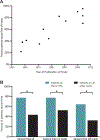Historical trend toward improved long-term outcome in childhood absence epilepsy - PubMed (original) (raw)
Meta-Analysis
Historical trend toward improved long-term outcome in childhood absence epilepsy
Elliot Morse et al. Epilepsy Res. 2019 May.
Abstract
We retrospectively analyzed published studies to investigate historical trends in outcome of childhood absence epilepsy (CAE). We included patients based on onset of absence seizures in childhood, 3 Hz bilateral spike-wave discharges on EEG, and availability of seizure-free outcome data. The primary endpoint was seizure-freedom off medications by study publication year. We also analyzed relationships between seizure-freedom and 1. treatment medication, and 2. CAE diagnostic criteria. We included 29 studies published 1945-2013, encompassing 2416 patients. Seizure-freedom off medications was higher for studies after 1985 versus before 1975 (82% versus 35%; p < 0.001). Ethosuximide and valproate were used more commonly after 1985, and patients previously treated with ethosuximide or valproate had higher seizure-freedom off medications than those treated only with other medications (64% versus 32%; χ2>10; p < 0.001). Although differences in diagnostic criteria for early vs. later studies did not reach statistical significance, later studies tended to use normal EEG background (p = 0.09) and absence of comorbid disorders (p = 0.09) as criteria more commonly. These findings demonstrate that seizure-freedom off medications has improved in published CAE studies after 1985. Our results are limited due to retrospective analysis. Further work is needed with prospective, controlled trials to establish factors leading to improved long-term prognosis in CAE.
Keywords: Childhood absence epilepsy; Epileptogenesis; Ethosuximide; Prognosis; Valproate.
Copyright © 2019 Elsevier B.V. All rights reserved.
Conflict of interest statement
Disclosures of Conflicts of Interest
The authors have no conflicts of interest to disclose.
Figures
Figure 1. Seizure-free outcome off medications has improved over time, and is better following treatment with ethosuximide or valproate.
A. Percent of patients experiencing seizure freedom off medications plotted with respect to year of study publication (Table 1). Studies published prior to 1975 had significantly lower rates of seizure freedom than those published after 1985 (p < 0.001, two-tailed t-test). Note: there are 2 studies presented that were published in 1963, with cure rates of 37.5% and 38%, therefore the datapoint at this timepoint consists of 2 overlapping datapoints. B. Percent of subjects experiencing seizure freedom overall (Seizure free all), while on medication, and once off medication, in patients treated with ethosuximide (ESX) or valproate (VPA) versus all other medications. A significantly higher rate of seizure freedom was found in all three groups in patients treated with ESX or VPA compared to those treated with other medications. * p < 0.001, chi-squared analysis (see text).
Similar articles
- Ethosuximide, sodium valproate or lamotrigine for absence seizures in children and adolescents.
Brigo F, Igwe SC. Brigo F, et al. Cochrane Database Syst Rev. 2017 Feb 14;2(2):CD003032. doi: 10.1002/14651858.CD003032.pub3. Cochrane Database Syst Rev. 2017. PMID: 28195639 Free PMC article. Updated. Review. - Ethosuximide, valproic acid, and lamotrigine in childhood absence epilepsy: initial monotherapy outcomes at 12 months.
Glauser TA, Cnaan A, Shinnar S, Hirtz DG, Dlugos D, Masur D, Clark PO, Adamson PC; Childhood Absence Epilepsy Study Team. Glauser TA, et al. Epilepsia. 2013 Jan;54(1):141-55. doi: 10.1111/epi.12028. Epub 2012 Nov 21. Epilepsia. 2013. PMID: 23167925 Free PMC article. Clinical Trial. - Ethosuximide, sodium valproate or lamotrigine for absence seizures in children and adolescents.
Posner EB, Mohamed K, Marson AG. Posner EB, et al. Cochrane Database Syst Rev. 2005 Oct 19;(4):CD003032. doi: 10.1002/14651858.CD003032.pub2. Cochrane Database Syst Rev. 2005. PMID: 16235312 Updated. Review. - Ethosuximide, sodium valproate or lamotrigine for absence seizures in children and adolescents.
Posner EB, Mohamed K, Marson AG. Posner EB, et al. Cochrane Database Syst Rev. 2003;(3):CD003032. doi: 10.1002/14651858.CD003032. Cochrane Database Syst Rev. 2003. PMID: 12917940 Updated. Review. - Long-term effectiveness of ethosuximide, valproic acid, and lamotrigine in childhood absence epilepsy.
Hwang H, Kim H, Kim SH, Kim SH, Lim BC, Chae JH, Choi JE, Kim KJ, Hwang YS. Hwang H, et al. Brain Dev. 2012 May;34(5):344-8. doi: 10.1016/j.braindev.2011.08.007. Epub 2011 Sep 3. Brain Dev. 2012. PMID: 21893390
Cited by
- Molecular Mechanisms Underlying the Generation of Absence Seizures: Identification of Potential Targets for Therapeutic Intervention.
Leitch B. Leitch B. Int J Mol Sci. 2024 Sep 11;25(18):9821. doi: 10.3390/ijms25189821. Int J Mol Sci. 2024. PMID: 39337309 Free PMC article. Review. - Long-term Prognosis of Childhood Absence Epilepsy.
Yaşgüçlükal MA, Özçelik EU, Deniz Elmali A, Çokar Ö, Demirbilek V. Yaşgüçlükal MA, et al. Noro Psikiyatr Ars. 2024 Feb 26;61(1):85-89. doi: 10.29399/npa.28583. eCollection 2024. Noro Psikiyatr Ars. 2024. PMID: 38496228 Free PMC article. Review. - Thalamocortical circuits in generalized epilepsy: Pathophysiologic mechanisms and therapeutic targets.
Lindquist BE, Timbie C, Voskobiynyk Y, Paz JT. Lindquist BE, et al. Neurobiol Dis. 2023 Jun 1;181:106094. doi: 10.1016/j.nbd.2023.106094. Epub 2023 Mar 27. Neurobiol Dis. 2023. PMID: 36990364 Free PMC article. Review. - Clinical and Instrumental Follow-Up of Childhood Absence Epilepsy (CAE): Exploration of Prognostic Factors.
Amianto F, Davico C, Bertino F, Bartolini L, Vittorini R, Vacchetti M, Vitiello B. Amianto F, et al. Children (Basel). 2022 Sep 23;9(10):1452. doi: 10.3390/children9101452. Children (Basel). 2022. PMID: 36291387 Free PMC article. - Maladaptive myelination promotes generalized epilepsy progression.
Knowles JK, Xu H, Soane C, Batra A, Saucedo T, Frost E, Tam LT, Fraga D, Ni L, Villar K, Talmi S, Huguenard JR, Monje M. Knowles JK, et al. Nat Neurosci. 2022 May;25(5):596-606. doi: 10.1038/s41593-022-01052-2. Epub 2022 May 2. Nat Neurosci. 2022. PMID: 35501379 Free PMC article.
References
- Blumenfeld H, Klein JP, Schridde U, Vestal M, Rice T, Khera DS, Bashyal C, Giblin K, Paul-Laughinghouse C, Wang F, Phadke A, Mission J, Agarwal RK, Englot DJ, Motelow J, Nersesyan H, Waxman SG, Levin AR, 2008. Early treatment suppresses the development of spike-wave epilepsy in a rat model. Epilepsia 49, 400–9. 10.1111/j.1528-1167.2007.01458.x - DOI - PMC - PubMed
Publication types
MeSH terms
Substances
LinkOut - more resources
Full Text Sources
